Taylor D.A. Introduction to marine engineering
Подождите немного. Документ загружается.

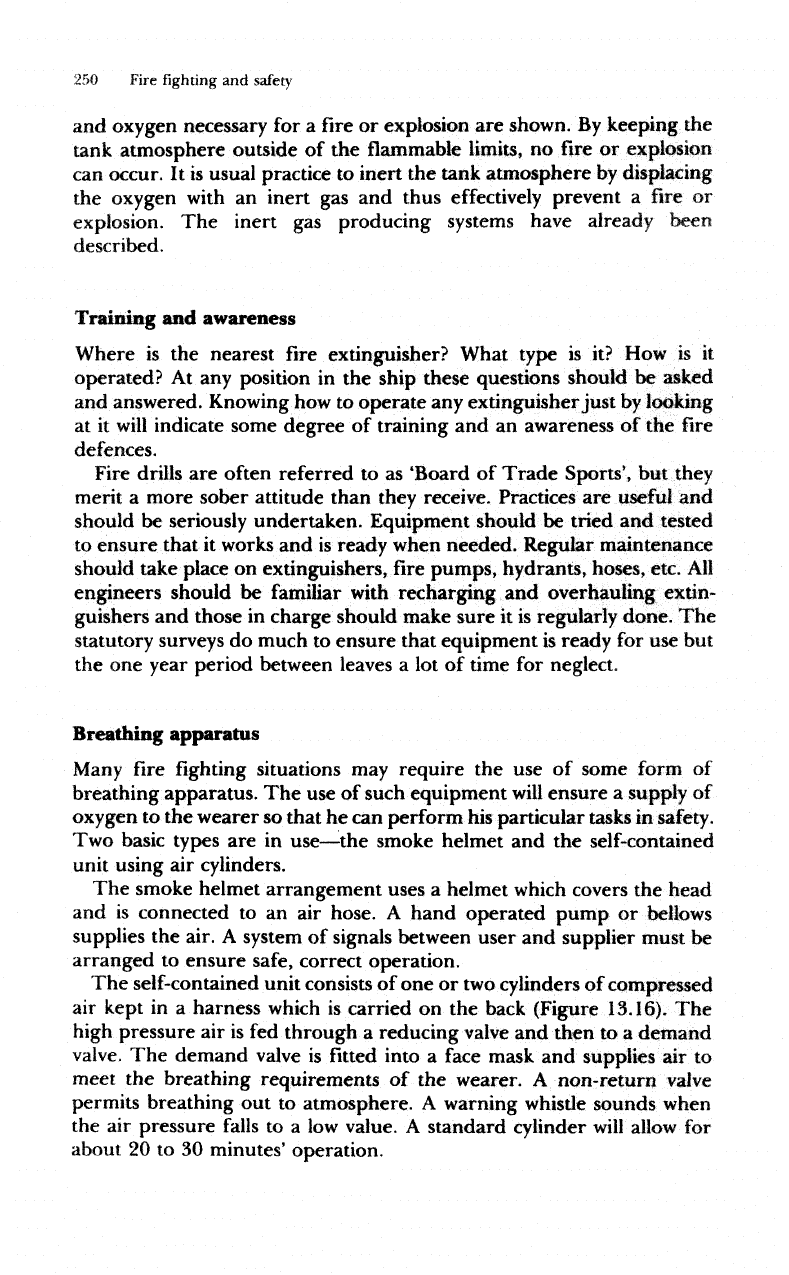
250
Fire
fighting and
safety
and
oxygen necessary
for a fire or
explosion
are
shown.
By
keeping
the
tank
atmosphere outside
of the flammable
limits,
no
fire
or
explosion
can
occur.
It is
usual practice
to
inert
the
tank atmosphere
by
displacing
the
oxygen
with
an
inert
gas and
thus
effectively
prevent
a fire or
explosion.
The
inert
gas
producing
systems
have already been
described.
Training
and
awareness
Where
is the
nearest
fire
extinguisher? What type
is it? How is it
operated?
At any
position
in the
ship these questions should
be
asked
and
answered. Knowing
how to
operate
any
extinguisher just
by
looking
at
it
will
indicate some degree
of
training
and an
awareness
of the fire
defences.
Fire drills
are
often
referred
to as
'Board
of
Trade
Sports',
but
they
merit
a
more sober attitude than
they
receive.
Practices
are
useful
and
should
be
seriously undertaken. Equipment should
be
tried
and
tested
to
ensure that
it
works
and is
ready when
needed.
Regular maintenance
should take place
on
extinguishers,
fire
pumps, hydrants, hoses, etc.
All
engineers should
be
familiar
with
recharging
and
overhauling extin-
guishers
and
those
in
charge
should
make sure
it is
regularly
done.
The
statutory
surveys
do
much
to
ensure that equipment
is
ready
for use but
the one
year period between
leaves
a lot of
time
for
neglect.
Breathing apparatus
Many
fire fighting
situations
may
require
the use of
some
form
of
breathing apparatus.
The use of
such equipment
will
ensure
a
supply
of
oxygen
to the
wearer
so
that
he can
perform
his
particular tasks
in
safety.
Two
basic types
are in
use—the
smoke helmet
and the
self-contained
unit
using
air
cylinders.
The
smoke
helmet
arrangement uses
a
helmet
which
covers
the
head
and
is
connected
to an air
hose.
A
hand operated
pump
or
bellows
supplies
the
air.
A
system
of
signals
between user
and
supplier must
be
arranged
to
ensure
safe,
correct operation.
The
self-contained unit consists
of one or two
cylinders
of
compressed
air
kept
in a
harness
which
is
carried
on the
back
(Figure
13.16).
The
high
pressure
air is fed
through
a
reducing
valve
and
then
to a
demand
valve.
The
demand
valve
is fitted
into
a
face
mask
and
supplies
air to
meet
the
breathing requirements
of the
wearer.
A
non-return
valve
permits
breathing
out to
atmosphere.
A
warning whisde sounds
when
the air
pressure
falls
to a low
value.
A
standard cylinder
will
allow
for
about
20 to 30
minutes'
operation.
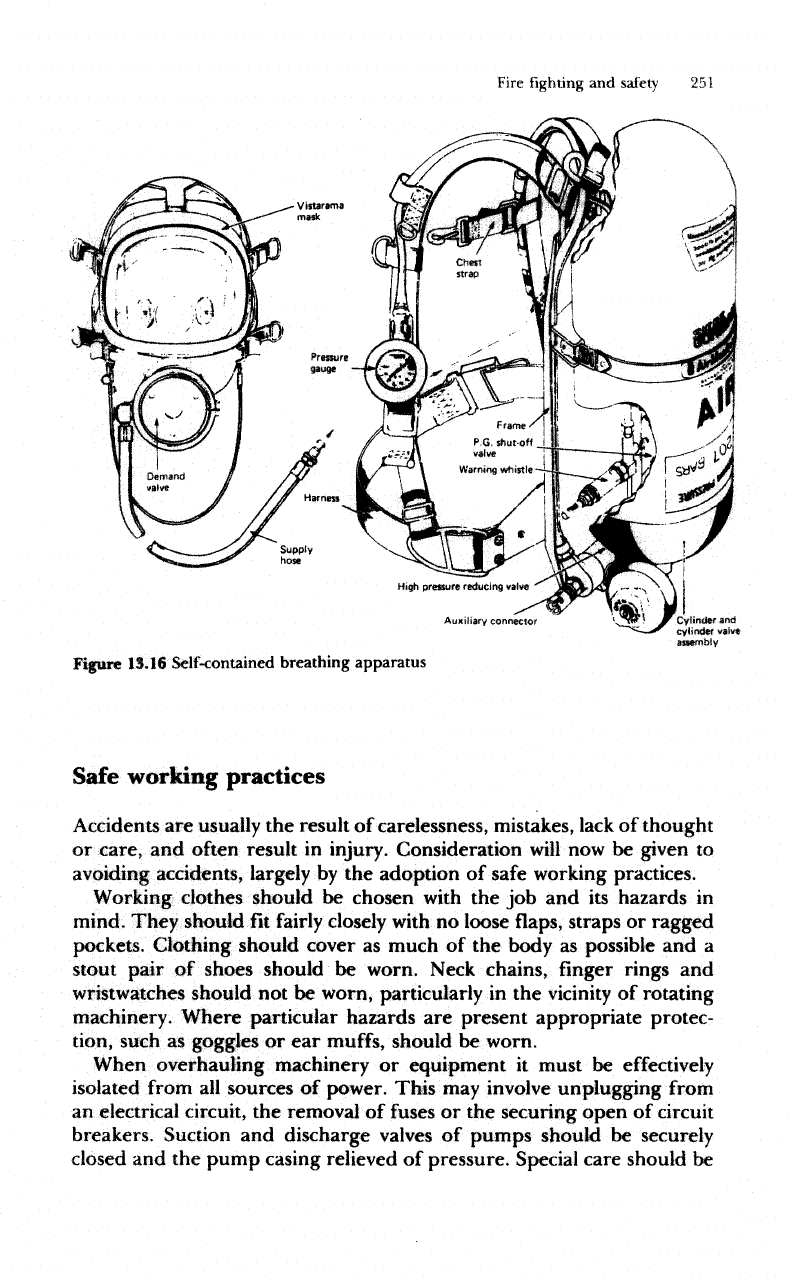
Fire
fighting and
safety
251
High
pressure
reducing
valve
'
^
Auxiliary
connector
Figure
IS.
16
Self-contained
breathing apparatus
Safe
working
practices
Accidents
are
usually
the
result
of
carelessness, mistakes,
lack
of
thought
or
care,
and
often
result
in
injury.
Consideration
will
now be
given
to
avoiding
accidents, largely
by the
adoption
of
safe
working practices.
Working
clothes should
be
chosen
with
the job and its
hazards
in
mind.
They should
fit
fairly
closely
with
no
loose
flaps,
straps
or
ragged
pockets.
Clothing
should cover
as
much
of the
body
as
possible
and a
stout pair
of
shoes should
be
worn.
Neck
chains, finger rings
and
wristwatches
should
not be
worn, particularly
in the
vicinity
of
rotating
machinery.
Where particular hazards
are
present
appropriate
protec-
tion,
such
as
goggles
or ear
muffs,
should
be
worn.
When
overhauling
machinery
or
equipment
it
must
be
effectively
isolated
from
all
sources
of
power. This
may
involve unplugging
from
an
electrical circuit,
the
removal
of
fuses
or the
securing
open
of
circuit
breakers.
Suction
and
discharge
valves
of
pumps should
be
securely
closed
and the
pump casing relieved
of
pressure. Special care should
be
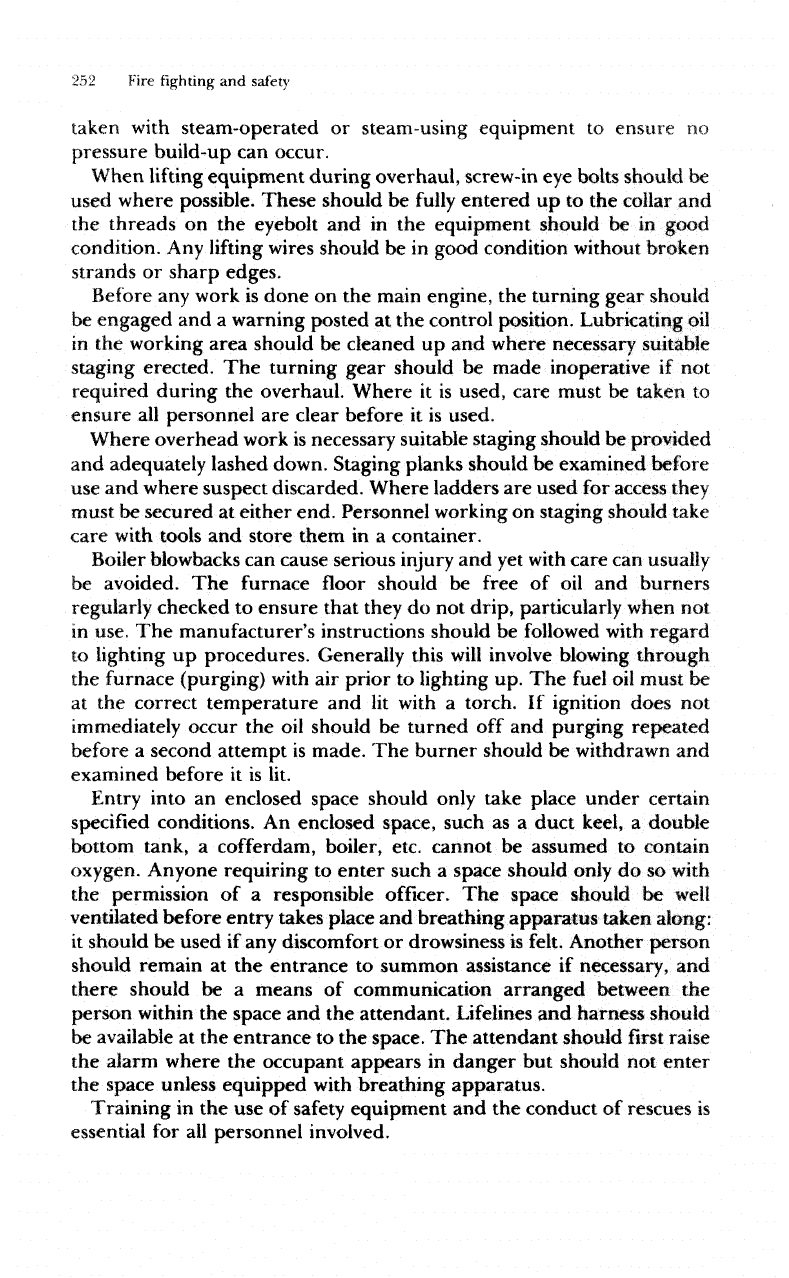
252
Fire fighting
and
safety
taken
with
steam-operated
or
steam-using
equipment
to
ensure
no
pressure build-up
can
occur.
When
lifting
equipment during overhaul, screw-in
eye
bolts should
be
used where possible.
These
should
be
fully
entered
up to the
collar
and
the
threads
on the
eyebolt
and in the
equipment should
be in
good
condition.
Any
lifting
wires should
be in
good condition
without
broken
strands
or
sharp edges.
Before
any
work
is
done
on the
main engine,
the
turning gear should
be
engaged
and a
warning
posted
at the
control position. Lubricating
oil
in
the
working
area should
be
cleaned
up and
where necessary
suitable
staging erected.
The
turning gear should
be
made inoperative
if not
required during
the
overhaul. Where
it is
used, care must
be
taken
to
ensure
ail
personnel
are
clear before
it is
used.
Where
overhead work
is
necessary suitable staging should
be
provided
and
adequately lashed down. Staging planks should
be
examined before
use
and
where suspect discarded. Where ladders
are
used
for
access they
must
be
secured
at
either end. Personnel
working
on
staging should take
care
with
tools
and
store
them
in a
container.
Boiler
blowbacks
can
cause serious
injury
and yet
with
care
can
usually
be
avoided.
The
furnace floor should
be
free
of oil and
burners
regularly
checked
to
ensure that they
do not
drip, particularly
when
not
in
use.
The
manufacturer's instructions should
be
followed
with
regard
to
lighting
up
procedures. Generally this
will
involve
blowing through
the
furnace (purging)
with
air
prior
to
lighting
up. The
fuel
oil
must
be
at
the
correct temperature
and lit
with
a
torch.
If
ignition does
not
immediately
occur
the oil
should
be
turned
off and
purging
repeated
before
a
second attempt
is
made.
The
burner should
be
withdrawn
and
examined
before
it is
lit.
Entry
into
an
enclosed space should only take place under certain
specified
conditions.
An
enclosed space, such
as a
duct keel,
a
double
bottom tank,
a
cofferdam, boiler, etc. cannot
be
assumed
to
contain
oxygen.
Anyone requiring
to
enter such
a
space should only
do so
with
the
permission
of
a
responsible officer.
The
space should
be
well
ventilated before entry takes place
and
breathing apparatus taken along;
it
should
be
used
if any
discomfort
or
drowsiness
is
felt.
Another
person
should remain
at the
entrance
to
summon assistance
if
necessary,
and
there should
be a
means
of
communication arranged
between
the
person
within
the
space
and the
attendant. Lifelines
and
harness should
be
available
at the
entrance
to the
space.
The
attendant should
first
raise
the
alarm
where
the
occupant appears
in
danger
but
should
not
enter
the
space unless equipped with breathing apparatus.
Training
in the use of
safety
equipment
and the
conduct
of
rescues
is
essential
for all
personnel involved.
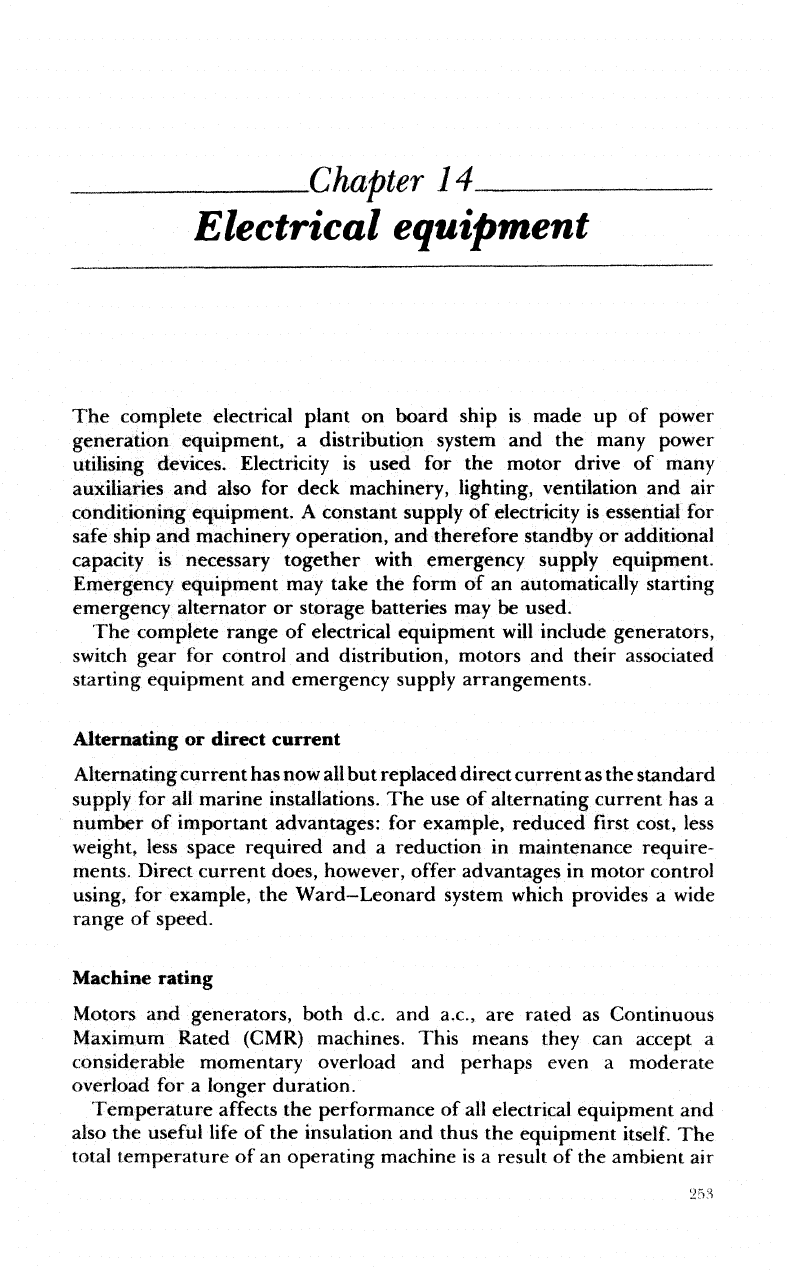
The
complete electrical plant
on
board ship
is
made
up of
power
generation equipment,
a
distribution
system
and the
many
power
utilising devices. Electricity
is
used
for the
motor drive
of
many
auxiliaries
and
also
for
deck machinery, lighting, ventilation
and air
conditioning
equipment.
A
constant supply
of
electricity
is
essential
for
safe
ship
and
machinery
operation,
and
therefore standby
or
additional
capacity
is
necessary
together
with
emergency supply equipment.
Emergency equipment
may
take
the
form
of an
automatically starting
emergency
alternator
or
storage
batteries
may be
used.
The
complete range
of
electrical equipment
will
include generators,
switch
gear
for
control
and
distribution, motors
and
their associated
starting
equipment
and
emergency supply arrangements.
Alternating
or
direct current
Alternating current
has now
all
but
replaced direct current
as the
standard
supply
for all
marine installations.
The use of
alternating current
has a
number
of
important advantages:
for
example, reduced
first
cost, less
weight,
less space required
and a
reduction
in
maintenance require-
ments.
Direct current does, however,
offer
advantages
in
motor control
using,
for
example,
the
Ward-Leonard
system
which
provides
a
wide
range
of
speed.
Machine rating
Motors
and
generators, both d.c.
and
a.c.,
are
rated
as
Continuous
Maximum
Rated (CMR) machines. This means
they
can
accept
a
considerable momentary overload
and
perhaps even
a
moderate
overload
for a
longer duration.
Temperature
affects
the
performance
of all
electrical equipment
and
also
the
useful
life
of the
insulation
and
thus
the
equipment itself.
The
total
temperature
of an
operating machine
is a
result
of the
ambient
air
Chapter
74_
Electrical
equipment
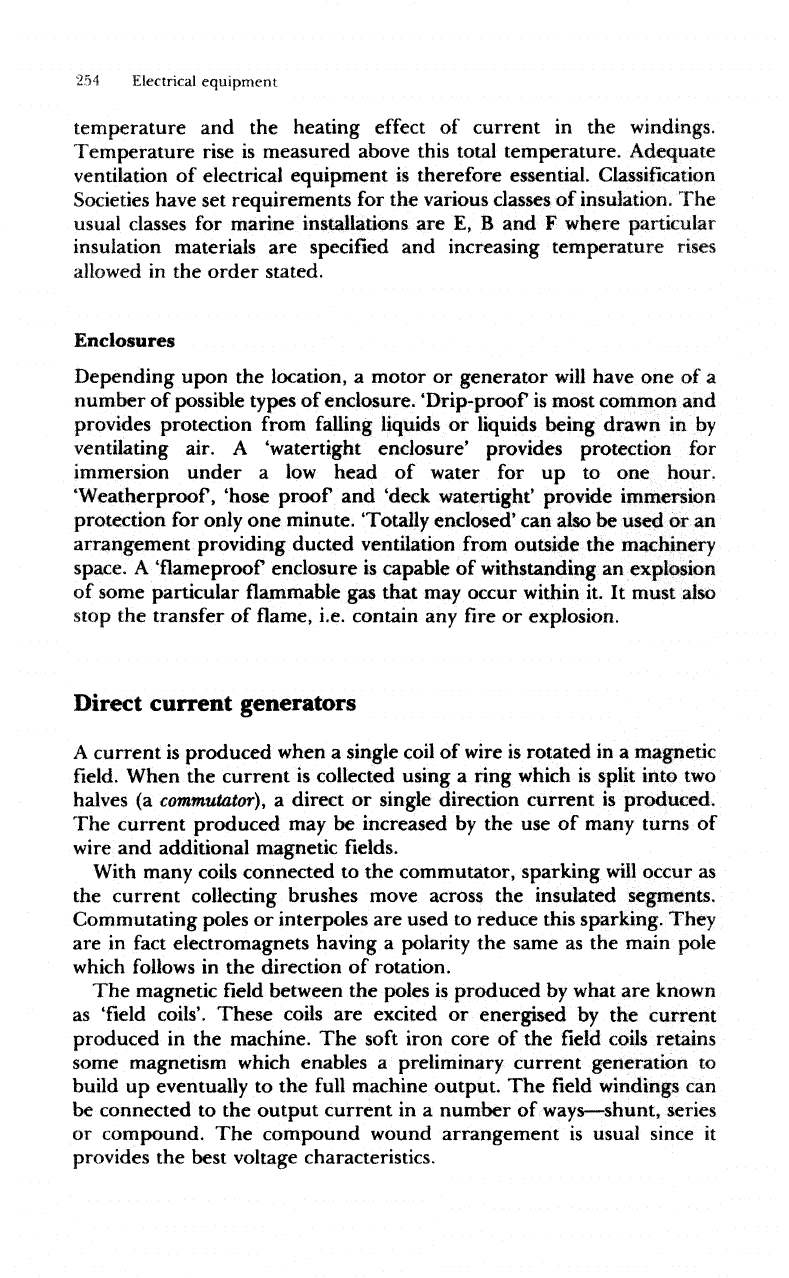
254
Electrical
equipment
temperature
and the
heating
effect
of
current
in the
windings,
Temperature rise
is
measured above this total temperature. Adequate
ventilation
of
electrical equipment
is
therefore essential. Classification
Societies
have
set
requirements
for the
various classes
of
insulation.
The
usual
classes
for
marine
installations
are E, B and F
where particular
insulation
materials
are
specified
and
increasing temperature rises
allowed
in the
order
stated.
Enclosures
Depending upon
the
location,
a
motor
or
generator
will
have
one of a
number
of
possible types
of
enclosure.
'Drip-proof
is
most common
and
provides protection from falling liquids
or
liquids being drawn
in by
ventilating
air.
A
'watertight
enclosure'
provides protection
for
immersion
under
a low
head
of
water
for up to one
hour.
'Weatherproof,
'hose
proof
and
'deck
watertight'
provide immersion
protection
for
only
one
minute.
'Totally
enclosed'
can
also
be
used
or an
arrangement providing ducted ventilation
from
outside
the
machinery
space.
A
'flameproof
enclosure
is
capable
of
withstanding
an
explosion
of
some particular
flammable gas
that
may
occur
within
it. It
must
also
stop
the
transfer
of flame,
i.e. contain
any fire or
explosion.
Direct
current
generators
A
current
is
produced when
a
single coil
of
wire
is
rotated
in a
magnetic
field.
When
the
current
is
collected
using
a
ring
which
is
split
into
two
halves
(a
commutator),
a
direct
or
single direction current
is
produced.
The
current produced
may be
increased
by the use of
many
turns
of
wire
and
additional magnetic
fields.
With
many
coils connected
to the
commutator, sparking
will
occur
as
the
current collecting brushes move across
the
insulated segments.
Commutating
poles
or
interpoles
are
used
to
reduce this sparking. They
are in
fact
electromagnets having
a
polarity
the
same
as the
main
pole
which
follows
in the
direction
of
rotation.
The
magnetic
field
between
the
poles
is
produced
by
what
are
known
as
'field
coils'.
These
coils
are
excited
or
energised
by the
current
produced
in the
machine.
The
soft
iron core
of the field
coils retains
some
magnetism
which
enables
a
preliminary
current generation
to
build
up
eventually
to the
full
machine output.
The field
windings
can
be
connected
to the
output current
in a
number
of
ways—shunt,
series
or
compound.
The
compound wound arrangement
is
usual
since
it
provides
the
best voltage characteristics.
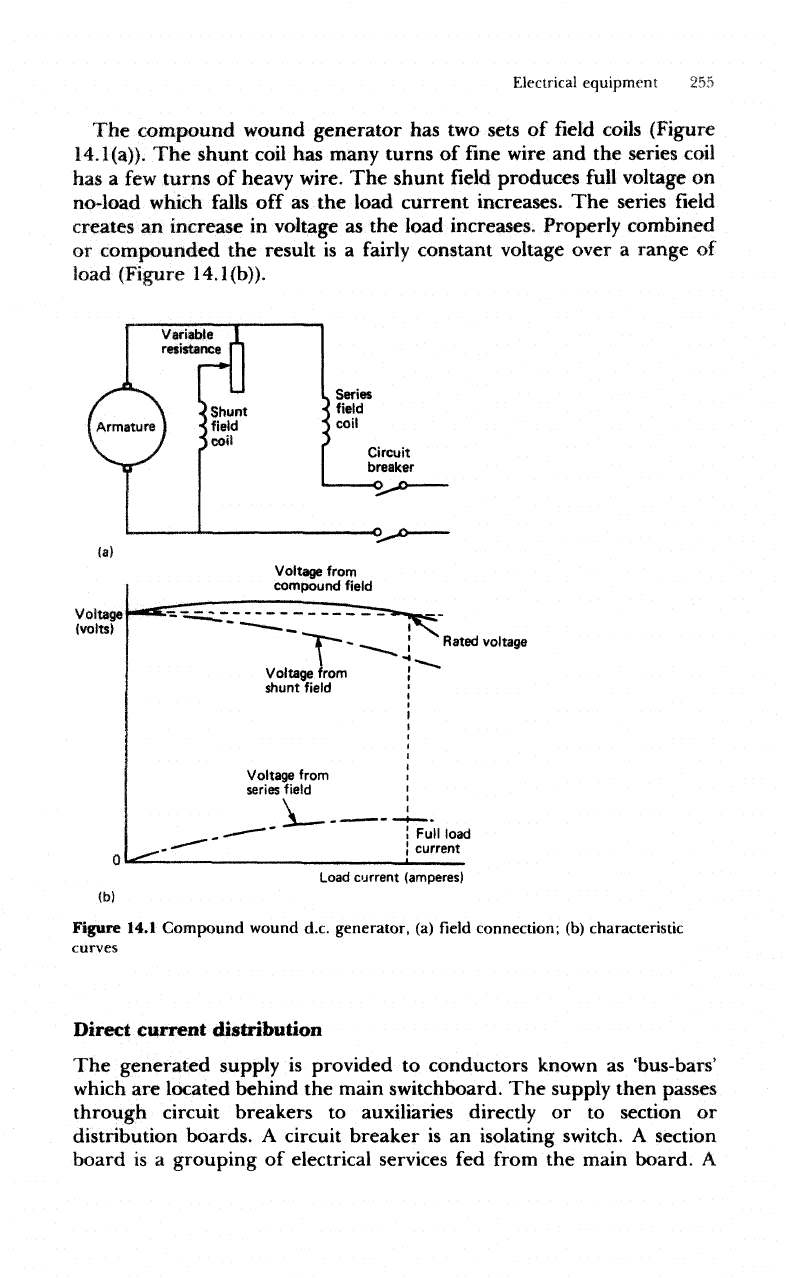
Electrical
equipment
255
The
compound
wound
generator
has two
sets
of
field coils (Figure
14.1
(a)).
The
shunt coil
has
many turns
of fine
wire
and the
series coil
has
a few
turns
of
heavy wire.
The
shunt
field
produces
full
voltage
on
no-load which
falls
off as the
load current increases.
The
series
field
creates
an
increase
in
voltage
as the
load increases. Properly combined
or
compounded
the
result
is a
fairly
constant voltage over
a
range
of
load
(Figure
14.1(b)).
Variat
resists
I.
|N
V
tie
nee
—
»
ft
Voltage
{volts)
Voltage
from
compound
field
Voltage
from
shunt
field
Voltage from
series
field
'
Rated voltage
Full
load
!
current
Load
current
(amperes)
(b)
Figure 14.1 Compound wound d.c. generator,
(a) field
connection;
(b)
characteristic
curves
Direct
current
distribution
The
generated supply
is
provided
to
conductors
known
as
'bus-bars'
which
are
located behind
the
main switchboard.
The
supply then passes
through circuit breakers
to
auxiliaries directly
or to
section
or
distribution
boards.
A
circuit breaker
is an
isolating
switch.
A
section
board
is a
grouping
of
electrical services
fed
from
the
main
board.
A
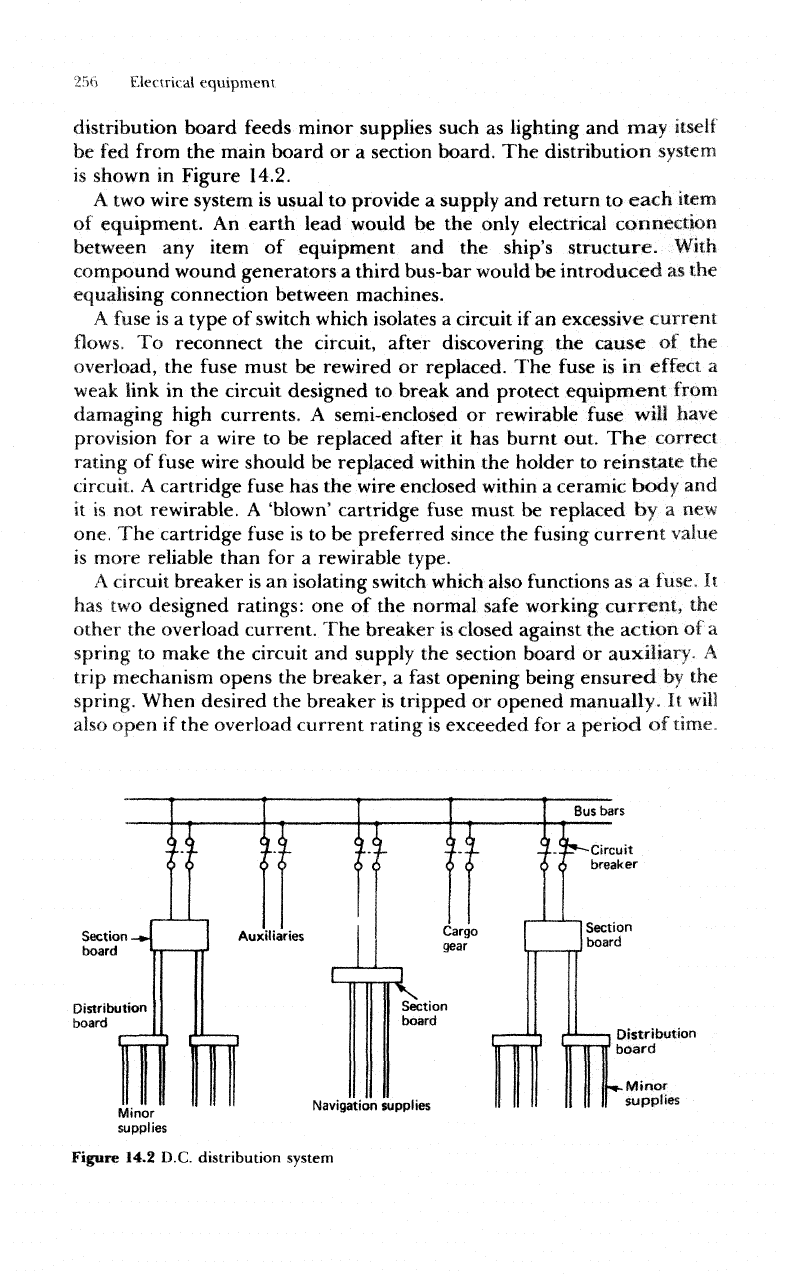
256
Electrical equipment.
distribution board feeds minor supplies such
as
lighting
and may
itself
be fed
from
the
main board
or a
section
board.
The
distribution
system
is
shown
in
Figure
14.2.
A
two
wire system
is
usual
to
provide
a
supply
and
return
to
each
item
of
equipment.
An
earth lead would
be the
only electrical connection
between
any
item
of
equipment
and the
ship's structure.
With
compound wound generators
a
third bus-bar would
be
introduced
as the
equalising connection between machines.
A
fuse
is a
type
of
switch
which
isolates
a
circuit
if an
excessive current
flows. To
reconnect
the
circuit, after discovering
the
cause
of the
overload,
the
fuse
must
be
rewired
or
replaced.
The
fuse
is in
effect
a
weak
link
in the
circuit
designed
to
break
and
protect
equipment
from
damaging
high currents.
A
semi-enclosed
or
rewirable
fuse
will have
provision
for a
wire
to be
replaced after
it has
burnt
out.
The
correct
rating
of
fuse
wire should
be
replaced
within
the
holder
to
reinstate
the
circuit.
A
cartridge
fuse
has the
wire enclosed
within
a
ceramic
body
and
it
is not
rewirable.
A
'blown'
cartridge
fuse
must
be
replaced
by a
new
one,
The
cartridge
fuse
is to be
preferred since
the
fusing
current
value
is
more
reliable
than
for a
rewirable type.
A
circuit breaker
is an
isolating
switch
which
also
functions
as a
fuse.
It
has
two
designed ratings:
one of the
normal
safe
working
current,
the
other
the
overload current.
The
breaker
is
closed
against
the
action
of a
spring
to
make
the
circuit
and
supply
the
section board
or
auxiliary.
A
trip
mechanism opens
the
breaker,
a
fast
opening being
ensured
by the
spring.
When desired
the
breaker
is
tripped
or
opened manually.
It
will
also
open
if the
overload current
rating
is
exceeded
for a
period
of
time.
Auxiliaries
Cargo
Section
board
Navigation
supplies
Figure
14.2 D.C. distribution
system
Minor
supplies
Bus
bars
Circuit
breaker
Section
board
Distribution
board
.Minor
supplies

Electrical
equipment
257
A
delay mechanism prevents
the
breaker
opening
for
short-period
overload currents.
The
circuit breaker opens
or
closes both supply
and
return
leads
in the
circuit. Where
a
circuit breaker feeds
the
generator
supply
to the
bus-bars
a
third
'make-or-break'
arm
will
be
provided
for
the
equaliser
connection.
Preferential
tripping
is a
means
of
retaining essential electrical
supplies.
In the
event that
a
generator
cannot supply
all the
load then
non-essential loads
are
disconnected
by
preferential trips.
The
intention
is
to
reduce
the
generator load while ensuring essential equipment such
as
steering
gear,
navigation lights, etc.,
retains
its
electrical
supply.
Various circuit faults
can
occur
as a
result
of
either
a
break
in the
conductor (cable)
or a
break
in the
insulation.
An
open-circuit
fault
results from
a
break
in the
conductor
and no
current
flow
will
take place,
A
short-circuit
fault
is due to two
breaks
in the
insulation
on,
for
example, adjacent conductors.
The two
conductors
are
connected
and a
large current
flow
takes place.
An
earth
fault
occurs when
a
break
in the
insulation
permits
the
conductor
to
touch
an
earthed
metal
enclosure
(or
the
hull).
Earth
faults
are
usually
detected
by the use of
earth indicating lamps.
Two
lamps
are
used, each rated
for the
full
system
voltage,
but
connected
in
series
across
the
system with
the mid
point
earthed
(Figure
14.3),
If the
system
is
correctly insulated then both lamps
will
glow
at
Bus
bars
Lamp Lamp
Figure
14.3 Earth
lamp
circuit
half
brilliance.
The
lamps
are
placed close together
to
enable
a
comparison
to be
made.
A
direct
earth
in one
pole
will
short circuit
its
lamp,
causing
the
other
to
shine
brighdy.
A
slight
insulation
breakdown
would
produce
a
difference
in
bulb brightness between
the
two. Where
an
earth
fault
is
detected
the
circuit
breakers
for
each separate
circuit
must
be
opened
in
turn
until
the
fault
location
is
discovered.
The
particular
section
or
distribution
box
would then have
to
have
its
circuits
investigated
one by one to
locate
the
fault
and
enable
its
correction.
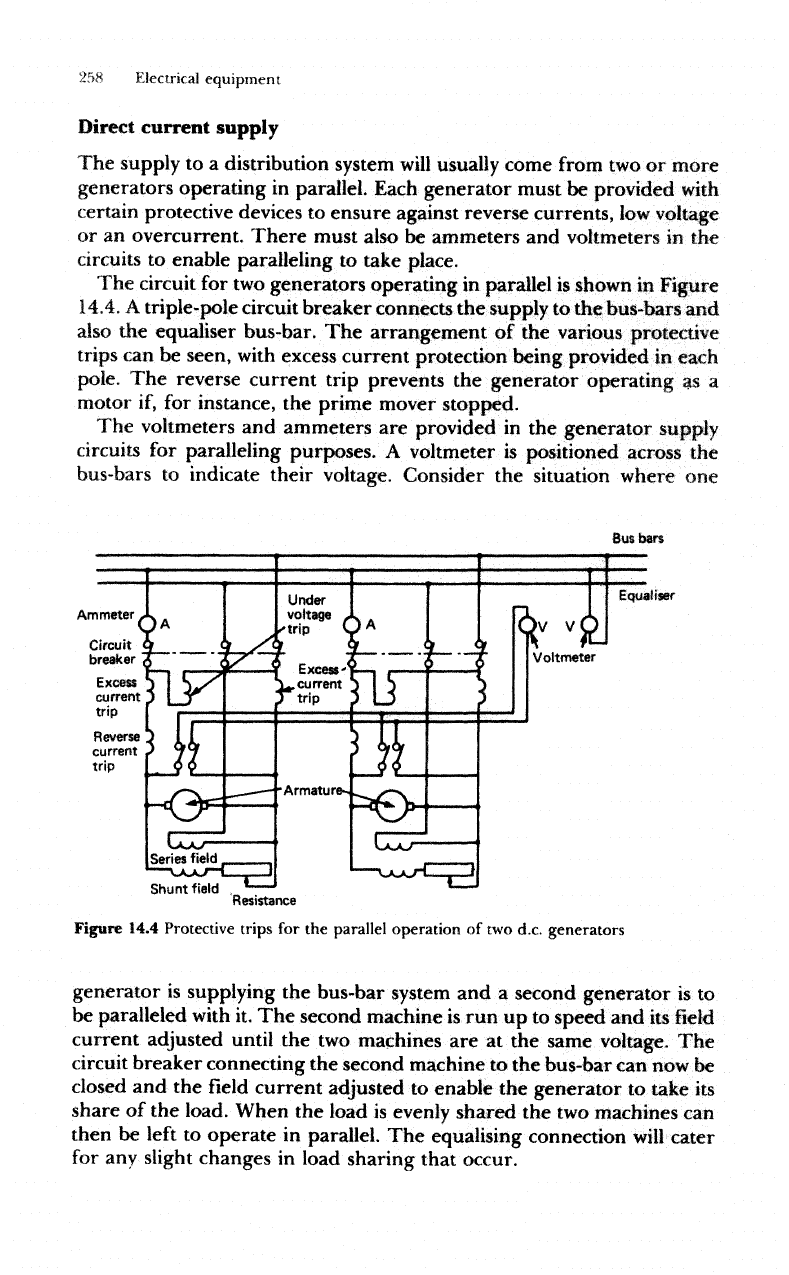
258
Electrical
equipment
Direct
current supply
The
supply
to a
distribution
system
will
usually come
from
two or
more
generators operating
in
parallel. Each generator must
be
provided
with
certain
protective devices
to
ensure against reverse currents,
low
voltage
or an
overcurrent.
There
must
also
be
ammeters
and
voltmeters
in the
circuits
to
enable paralleling
to
take place.
The
circuit
for two
generators
operating
in
parallel
is
shown
in
Figure
14.4.
A
triple-pole circuit breaker connects
the
supply
to the
bus-bars
and
also
the
equaliser bus-bar.
The
arrangement
of the
various protective
trips
can be
seen,
with
excess current protection being provided
in
each
pole.
The
reverse current trip prevents
the
generator
operating
as a
motor
if, for
instance,
the
prime mover stopped.
The
voltmeters
and
ammeters
are
provided
in the
generator
supply
circuits
for
paralleling purposes.
A
voltmeter
is
positioned
across
the
bus-bars
to
indicate their voltage. Consider
the
situation where
one
Bus
ban
Equaliser
Ammeter
Circuit
breaker
Series
field
1
—CA-A-T-
Shunt
field
,
Resistance
Figure 14.4
Protective
trips
for the
parallel
operation
of two
d,c.
generators
generator
is
supplying
the
bus-bar
system
and a
second
generator
is to
be
paralleled
with
it. The
second machine
is run up to
speed
and its field
current adjusted
until
the two
machines
are at the
same
voltage.
The
circuit
breaker connecting
the
second machine
to the
bus-bar
can now be
closed
and the
Field
current adjusted
to
enable
the
generator
to
take
its
share
of the
load. When
the
load
is
evenly
shared
the two
machines
can
then
be
left
to
operate
in
parallel.
The
equalising connection will cater
for
any
slight changes
in
load sharing that occur.
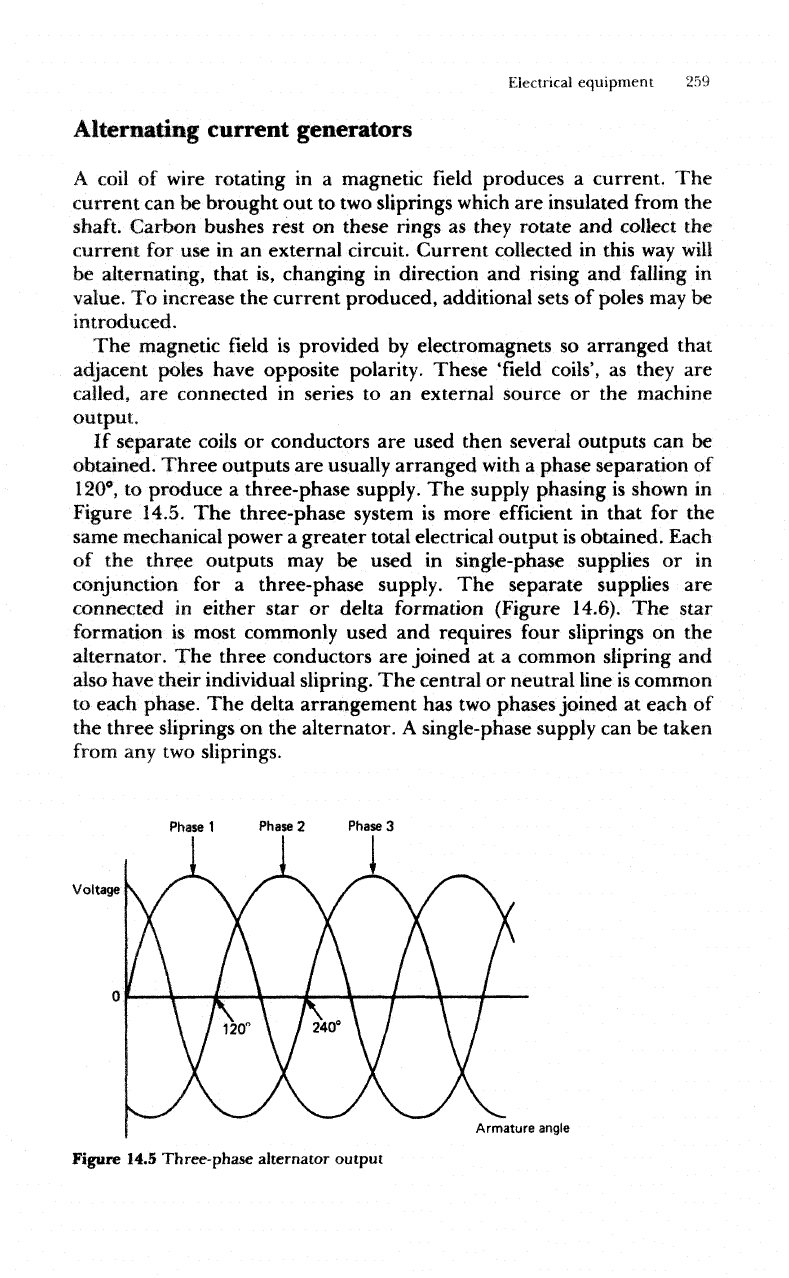
Electrical
equipment
259
Alternating
current
generators
A
coil
of
wire
rotating
in a
magnetic
field
produces
a
current.
The
current
can be
brought
out to two
sliprings
which
are
insulated
from
the
shaft.
Carbon
bushes
rest
on
these
rings
as
they rotate
and
collect
the
current
for use in an
external circuit. Current collected
in
this
way
will
be
alternating, that
is,
changing
in
direction
and rising and
falling
in
value.
To
increase
the
current produced, additional sets
of
poles
may be
introduced.
The
magnetic
field
is
provided
by
electromagnets
so
arranged that
adjacent
poles have opposite polarity. These
'field
coils',
as
they
are
called,
are
connected
in
series
to an
external source
or the
machine
output.
If
separate
coils
or
conductors
are
used then several outputs
can be
obtained.
Three
outputs
are
usually
arranged
with
a
phase separation
of
120°,
to
produce
a
three-phase supply.
The
supply phasing
is
shown
in
Figure 14.5.
The
three-phase system
is
more
efficient
in
that
for the
same
mechanical power
a
greater total electrical output
is
obtained. Each
of
the
three outputs
may be
used
in
single-phase supplies
or in
conjunction
for a
three-phase supply.
The
separate
supplies
are
connected
in
either
star
or
delta formation (Figure 14.6).
The
star
formation
is
most commonly used
and
requires
four
sliprings
on the
alternator.
The
three conductors
are
joined
at a
common slipring
and
also have their individual siipring.
The
central
or
neutral
line
is
common
to
each phase.
The
delta arrangement
has two
phases
joined
at
each
of
the
three sliprings
on the
alternator.
A
single-phase supply
can be
taken
from
any two
sliprings.
Phase
1
Phase
2
Phase
3
Voltage
Armature angle
Figure
14.5
Three-phase
alternator
output
